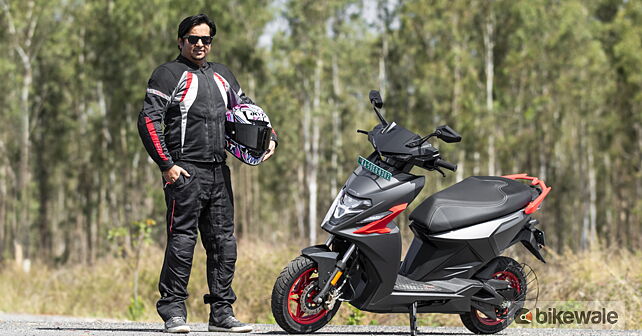Introduction
This is the new Simple One electric scooter, and it has received considerable updates to make it relevant against the competition. For 2025, Simple Energy has updated it with more features and made changes to its software and battery algorithms, offering more range and seamless performance. But how does it translate into the real world, and should you consider it in 2025? Time to find out.
The Visuals
Visually, the Simple One continues with the same styling as the older model. It continues to feature a sporty design language with sharp character lines and distinct visual elements. Although the overall silhouette does look similar to the Ather 450X, the sharp cuts and creases, the dual-tone paint finish, and elements such as the apron-mounted panels add a unique identity to the scooter.
Simple Energy has significantly improved the quality of the scooter compared to the last iteration. There are no uneven panel gaps, and the switch gear feels tactile to operate. That said, the plastic panel near the touchscreen dashboard could use a better finish, as it has too many sharp edges and doesn’t sit flush with the display.
The Package
Simple Energy has updated the features list on the One. The scooter now comes loaded with features such as TPMS, Park Assist, Find My Vehicle, customisable dash themes, rapid brake, OTA updates, trip history and statistics, a USB charging port, and updated regenerative braking. However, unlike the competition, Simple Energy hasn’t offered different levels of regen, and you can barely notice it while decelerating.
The scooter continues to get full LED illumination, a seven-inch touchscreen display with auto-brightness, full map navigation from Map My India, and four ride modes – Eco, Ride, Dash, and Sonic. The scooter rides on telescopic front forks and a rear monoshock while braking duties are handled by disc brakes at both ends along with the safety net of a combined braking system.
Despite having a portable secondary battery pack, the scooter offers an under-seat storage of over 30 litres. It can easily accommodate a basic full-face helmet, however, a full-blown race helmet may not fit properly.
The Ride
Powering the Simple One is an in-house developed electric motor that delivers an output of 8.5kW (11.4bhp) and a peak torque of 72Nm. This motor enables the scooter to accelerate from 0-40kph in 2.77 seconds while offering a top speed of 105kph. The scooter gets two battery packs: a floor-mounted 3.7kWh unit and a portable 1.3kWh pack. Simple Energy claims that it has made changes to the battery algorithm, which has increased the IDC range to 248km from the earlier 212km.
We mostly rode the scooter in the Dash or Sonic mode, and the throttle response felt very lively and alert. The slightest of inputs nudged the scooter ahead with ferocity, and never once did we feel the power was lacking. The Ride mode is more than enough for your daily commutes unless you want a sudden burst of power. Meanwhile, the Eco mode offers the maximum range and is good for making your way through city traffic. What’s commendable is that no matter which mode you ride in, there’s no jerkiness in the throttle calibration, and the scooter feels very natural and intuitive to operate.
While the updated claimed range has been increased to 248km, the display still showed the older 212km range. Simple Energy confirmed that the scooter was running the new software updates, but these weren’t calibrated on the instrument cluster. The company claims that the scooter offers a real-world range of over 185km. In our experience, even after riding the scooter for 15km in Eco and Ride modes, the range depleted only by 12km on the display. Even after multiple high-speed runs, riding at triple-digit speeds, and performing various acceleration tests in Sonic mode, we ended up with a 65 per cent battery range. That said, we can only test the exact real-world range once we get the scooter for a longer duration in Mumbai.
The Simple One is dynamically sorted as well, and the chassis complements its performance. The scooter feels planted around corners and takes the intended line without much effort. The suspension setup offers a good balance between sportiness and comfort. It isn’t outright plush and you will feel the underlying firmness. However, it doesn’t kick back or throw you off the seat. Speaking of seating comfort, Simple has used denser cushioning for the seat. It offers good support and, combined with the neutral ergonomics, feels very comfortable. However, if you are anywhere under 5’7′ in height, the wider inseam will obstruct your feet from comfortably reaching the ground.
The one aspect where I felt the scooter was lacking was in the braking department. The front brake lacks bite and progression and has a wooden feel to it. The rear brake, meanwhile, offered better stopping power, and you’d have to use both brakes in tandem to bring the scooter to a halt.
Should you buy it?
This is quite tricky to answer. The One, with all the updates to its features and performance, makes for a good e-scooter. It impresses with its performance and handling while being one of the sportiest offerings in the segment. However, it lacks in the braking department and misses out on features like traction modes, cruise control, hill hold, and more, which the competition offers.
Moreover, the portable battery pack is only used as a range extender and cannot be charged at home or office, thereby limiting its usability. Then, Simple Energy doesn’t offer any public charging networks or fast charging for its scooters. With the bundled home charger, the scooter takes nearly six hours to charge the battery pack from 0-80 per cent.
At Rs. 1.66 lakh (ex-showroom), the scooter is quite expensive for what it offers. And the limited sales and service reach (10 locations presently) doesn’t help its cause either.
Photography by Kaustubh Gandhi
Gallery
1/24
Simple Energy One TFT Touchscreen Instrument Cluster
Double Tap to Zoom

